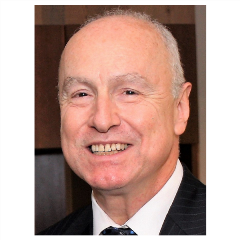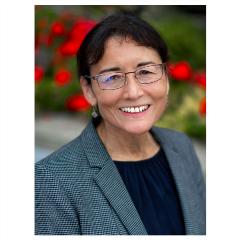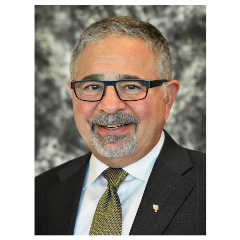To learn more about how the COVID-19 pandemic is reshaping the future of dentistry, WSDA News asked four experts — Drs. Gordon Christensen, Gary Chiodo, Beatrice Gandara and John Kois — for their take on where things are headed.
AT-A-GLANCE
- Experts agree that COVID-19 will force changes in the standard of care and dental practices.
- These changes will impact how dentists interact both with their patients and their staffs.
- Infrastructure and practice procedures will both evolve to improve infection control and enhance safety.
- COVID-19 isn’t the first microbial disruption to dental practices and it won’t be the last. The key is to be more prepared for future risks.
|
“The problem with the future is it ain’t what it used to be.”
In his own inimitable way, Yogi Berra perfectly summarized the COVID-19 environment facing every aspect of society. The COVID-19 pandemic, required social distancing measures, and resulting economic disruptions pose an unsettling future for Washington dentists.
To learn more about how this crisis is reshaping the future of dentistry, WSDA News asked four experts for their take on where things are headed:
.tmb-small.png?sfvrsn=7278038a_1)
Dr. Gordon Christensen
Founder and director of Practical Clinical Courses, an international continuing education organization, and publisher of Clinicians Report

Dr. Gary Chiodo
Dean, University of Washington School of Dentistry

Dr. Beatrice Gandara
Clinical Associate Professor, Oral Medicine, University of Washington School of Dentistry

Dr. John Kois
Founder and director of the Kois Center, a didactic and clinical teaching program, and editor-in-chief of The Compendium of Continuing Education in Dentistry
Their comments have been edited for length and readability.
Will dentists’ experiences in responding to the pandemic change the way they practice going forward? What will be the biggest challenges?
Chiodo: COVID-19 is not the first nor the last microbe to disrupt dental practice. In the 1980s, HIV and hepatitis C caused us to rethink infectious disease risks in our practices. They resulted in the implementation of universal body substance precautions (UBSP). Adoption of UBSP was not without controversy and, in some cases, frank rebellion. Now, UBSP is seamlessly integrated into all health care practices and is standard operating procedure. COVID-19 is resulting in further evolution of UBSP and the resulting changes will endure; we will not revert to lesser standards after this pandemic. As in business and industry, disruptors lead to evolution, advancement, improvement, and efficiencies. Both the physical infrastructure and processes for the practice of dentistry will evolve. COVID-19 is a warning to us to be better prepared for the next microbiological threat.
Kois: Delivery of dental care has always been the subject of many concerns related to dental aerosols and infection. However, COVID-19 has certainly heightened our awareness of these issues and created a new normal regarding the efficacy of intra- and extra-oral suction devices and ambient air quality management. I have changed or augmented these systems in my practice based on recent publications and will never go back to the way I practiced before. Most of the new normal is here to stay.
Gandara: Dentistry is a challenge because it is so technical but there is a lot you can do via telehealth. We are slowly getting back to more regular treatment, but let’s not forget these other elements we can grow and develop for a more enriched practice and expand care to reach more people. It’s easy to say, “Let’s get back to where we were.” I think that would be a mistake. We have to become more resilient.
Christensen: In addition to increased infection control, I sincerely hope all dentists focus on becoming better prepared for all aspects of life, including dental, mental, financial and spiritual. We “geezers” have weathered many such things; young people need to be prepared for the next challenge.
Will COVID-19 force bigger changes in how dentists care for their patients or how they manage their practices and staff?
Kois: I don’t think this is an either/or question. We have to do both. The Kois Center developed a webinar to provide dentists best practice solutions to the most significant challenges due to COVID-19. It has been downloaded more than 120,000 times. Uncertainties about the effectiveness of personal protective equipment, dental aerosols, and risk levels in treating asymptomatic yet contagious patients have increased dental professionals’ anxiety during this pandemic. A recent publication in the Journal of Dentistry (2020) estimated that the annualized probability for a dental worker to acquire COVID-19 infection in a dental office, become symptomatic, and die from the infection is 1:13,000. This is without use of face shields and pre-procedural oral rinses, which may further reduce the risk and the concerns. However, risks to high-risk staff or family members, which is still a significant concern for some, was not included. Personally, I feel safer in my dental practice than grocery shopping.
Chiodo: The two are inseparable. Both require fundamental changes in infrastructure and practice. Infrastructure is evolving to better manage aerosols so rapid removal at the source and inactivation prevent contagious agents from traveling in the immediate environment. Rather than placing primary risk reduction on the filter efficiency of a surgical mask, we will depend on eliminating the risk before it reaches the mask. That will require better technology deployed in the care of all patients.
Enhanced screening of patients and the implementation of reliable point-of-care testing will change the dynamic of the doctor-patient interaction. Patients are generally well-informed about this disease and are asking questions of all health care providers, dentists included. They expect to see visible evidence that we are implementing additional strategies to protect them: pre-treatment screening questions, social distancing in reception areas or asking them to remain in their cars until called, wearing masks except when being treated, taking their temperature, requesting a follow-up call if symptoms develop within 48 hours of an appointment, installing portable air filtration systems, and providing educational materials. This all must be integrated into the routine of dental practices and embraced by the staff, who are essential in reinforcing the importance of new protocols.
Gandara: I think we need to ask ourselves what are we learning from this and how can we better prepare for another emergency state? I have a bias being in oral medicine. Again, there’s a lot you can do in telehealth with diagnosis and medical management of oral disease to be more efficient with time when the patient is finally in your chair. The challenges are that dentists don’t think about providing care in a telehealth setting because we were not trained for it and the reimbursement systems don’t match the work it takes to do it correctly. Our staff can be an integral part of this expansion of care.
Will the pandemic change how dentists are educated and licensed, including continuing professional education?
Chiodo: It will change practice management education because new behaviors are required. Current students are now learning revised logistics of infection control in the clinic, and that will translate to their future practice. Licensing requirements will expand to recognize that screening and testing for infectious and contagious diseases is part of the standard of care. As point-of-care technology continues to improve and become commercially available, there will be an expectation that this will become part of the standard of care. To do less will be substandard care. This is a critically important role for the health of our patients, our staff, our families, and ourselves, and a fundamental and critically important public health obligation.
Christensen: Educators and licensing agencies will begin to see the need to be more oriented to “real world” problems. In terms of continuing education, I have provided over 50 virtual courses to more than 300,000 dentists and staff during the COVID experience, and can attest to the fact that virtual classes work somewhat, but the educational experience can’t be compared to live programs. Nevertheless, virtual courses will continue to be offered for those who can’t or won’t travel for various reasons.
Gandara: I think so. Dental conferences are now all online — so you do miss out on networking, which is important, too. For individual CDE, obviously if you are a good online learner, that’s helpful. Some people may learn better in-person. As we develop new innovations in the delivery of content, we will learn which methods best allow development of critical thinking skills while supporting technical skill development.
For training the dental students, we’ve gone online in ways we’ve never thought we could and have become more creative to figure it out. We have to see what kind of dentists come out at the other end. One thing for sure: I am very impressed and amazed by our students — they are totally receptive and open. I think a lot of the faculty are older and feel very challenged by this new methodology. But right now, everyone — it doesn’t matter if it’s in providing care or for education — needs to be more forgiving rather than fearful or distrustful or go into survival mode as we recover and adapt to the new norms.
Kois: This pandemic has influenced the way we transfer information, making more efficient use of existing resources like Zoom meetings or online learning. These formats have now become necessary to limit the size of gatherings, like continuing education classes. I see a blend of online and in-person learning becoming much more common. There is a big difference between transfer of information and education. Information is actually easy to transfer, but being able to process the information for the development of critical thinking and creativity is still challenging. The future of dentistry will require the use of both, but with significant changes.
Understanding that the pandemic is not yet behind us, what are your hopes for dentistry’s immediate future?
Kois: Most dentists have been busy in their practices since re-opening in May. Practices have noticed a reluctance in very high-risk patients to come in for routine procedures, but otherwise patients appreciate that we are able to take care of them. For some practitioners, the most immediate concern has been loss of key staff members due to their high-risk medical issues or proximity to retirement. Additionally, most share concerns regarding the impact COVID-19 will have on the economy, which impacts all of us.
Chiodo: We continue to receive predictions about a “second wave” of COVID-19 cases in fall or winter, but we have not completed the first wave. Because the public has not universally adopted behaviors required to decrease community-acquired infections, and, because we are still months away from an effective vaccine, we need to be prepared for another surge in cases. Being prepared this time means standing ready to continue our practices with enhanced infection control measures and point-of-care testing as appropriate. We know how to do this. We can do this safely. In fact, we can be a model for how to continue outpatient clinical services in the middle of a pandemic with no increase in risk to our patients or ourselves.
Christensen: We all need to be calm. Our profession is recovering. We are becoming financially stable again and the world is not ending. As COVID calms, near normality will return rapidly and joyfully!
Gandara: Obviously I hope that everyone’s practice survives and that people will think of new ways of being innovative and resilient. I think financially it has been hard for dentists who are now rebuilding the relationships they had.
There is so much going on that has stressed people out so much — from economics to infection control to race relations. Dentists are health care providers but they are also leaders. I feel they can be leaders and help calm their patients.
All of us have so much to give and help each other. We should try to do that and be thoughtful about best practices.
This article originally appeared in the Fall 2020 Issue of WSDA News.